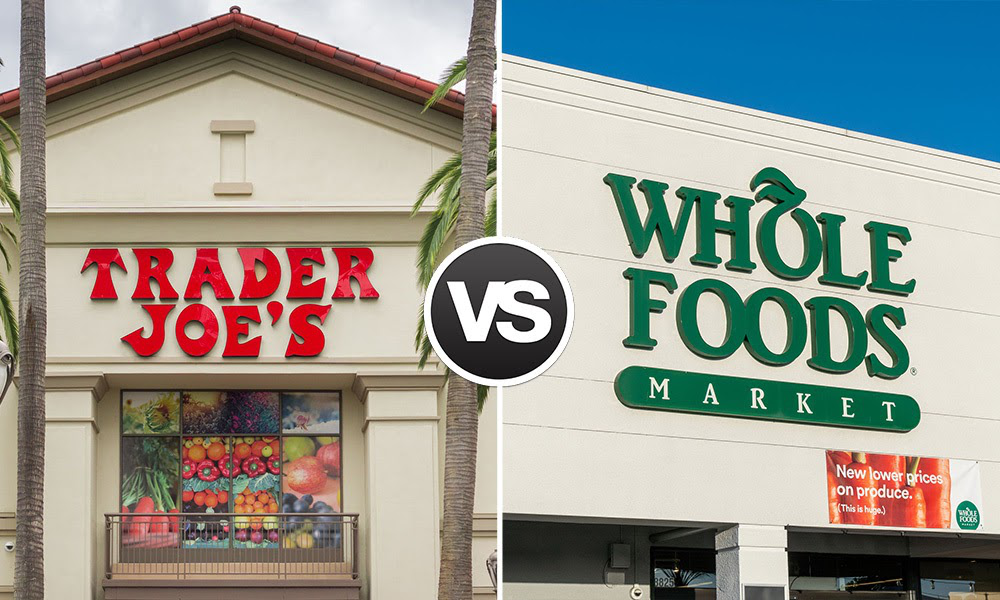
Trader Joe’s and Whole Foods are both health foods grocery stores with cult followings. Seriously. People just don’t love Kroger or Aldi the same way that they worship Trader Joe’s or Whole Foods, so this price comparison article might get a bit personal for some readers.
But we’re dedicated to getting to the bottom of which grocery store is better: Whole Foods or Trader Joe’s.
Both grocers have high-quality store-brand products, more natural and organic options than other grocery stores, and nearly ready-to-eat prepared foods that put the competition to shame.
But for a while, Whole Foods was known for its outrageously high prices–making Trader Joe’s the obvious choice for shoppers who prioritize low prices. So, how much has changed since Amazon bought this popular grocery store in 2017? Are the newer lower prices enough to compete with Trader Joe’s?
We’re going to find out with an ultimate shopping list that compares prices on various items from the major departments at each retailer.
Comparison Methodology: How We Compared Whole Foods and Trader Joe’s

For this Whole Foods vs. Trader Joe’s price comparison, we compiled a shopping list that examines popular categories from each store, including organic and non-organic produce, packaged snacks, drinks, personal care items (because there’s nothing better than a bar of fresh handmade soap) and prepared foods.
We wanted to explore what store you could save the most money at–and usually, that means shopping store brand items–especially since Trader Joe’s pushes their in-house brand hard.
When possible, we aimed to compare exactly the same brand item to show you which retailer gives a better deal. When different brands were compared, we noted which brand we looked at in parenthesis next to the item. Most of the time, that was Whole Food’s 365 brand and TJ’s official Trader Joe’s brand (which are really your favorite brands disguised as TJ’s merchandise… but more on that later!).
This price comparison was completed in July 2021 in the southwestern region of the US. That’s important to know because prices change all the time, and they vary per location. So, while this price comparison can give you a good idea of where to shop, don’t expect to find the same deals we did.
And don’t overlook rollbacks and special offers at either store! Finding great limited-time deals is the best way to save money wherever you shop.
Trader Joe’s vs. Whole Foods Price Comparison Summary
Here’s a savings snapshot where we break down our total cart price by category. As you can see, Trader Joe’s dominated this competition.
| Category | Trader Joe’s | Whole Foods | Savings |
| Organic Produce | $29.79 | $36.13 | $6.34 (17.55%) |
| Non-Organic Produce | $35.87 | $41.76 | $5.89 (14.1%) |
| Dairy Products | $19.14 | $22.75 | $3.61 (15.87%) |
| Frozen Foods | $16.95 | $23.88 | $6.93 (29.02%) |
| Non-Perishable Groceries | $31.44 | $40.15 | $8.71 (21.69%) |
| Prepared Foods | $22.63 | $30.40 | $7.77 (25.56%) |
| Packaged Snacks | $15.05 | $18.58 | $3.53 (19%) |
| Beverages | $20.90 | $32.89 | $11.99 (36.45%) |
| Personal Care Items | $21.95 | $53.00 | $31.05 (58.58%) |
| Total Cart Price | $213.72 | $299.54 | $85.82 (28.65%) |
Although we were expecting Trader Joe’s to have slightly lower prices in most categories, the consistency of these results was surprising. Trader Joe’s offered prices that were between 14-58% cheaper than Whole Foods, and on average, Trader Joe’s was almost 30% less expensive than Whole Foods.
We saved the most in the personal care and beverage aisles, where we saved a whopping $43 on just those two categories, spending $43 at TJ’s and $86 at Whole Foods.
But if you’re looking to save money, the lesson learned here is that Trader Joe’s and Whole Foods are both more expensive (for these two categories, at least) than a department store like Walmart or Target.
At the end of our shopping trip, we saved about $86 by choosing Trader Joe’s over Whole Foods, which goes to show that Whole Foods is still significantly more expensive than competitor health foods stores.
If you don’t have time to analyze the numbers but want a rundown of the pros and cons of shopping at Whole Foods and Trader Joe’s, skip down to the bottom of this article, where we tell you everything you need to know.
Trader Joe’s vs. Whole Foods: Organic Produce Price Comparison
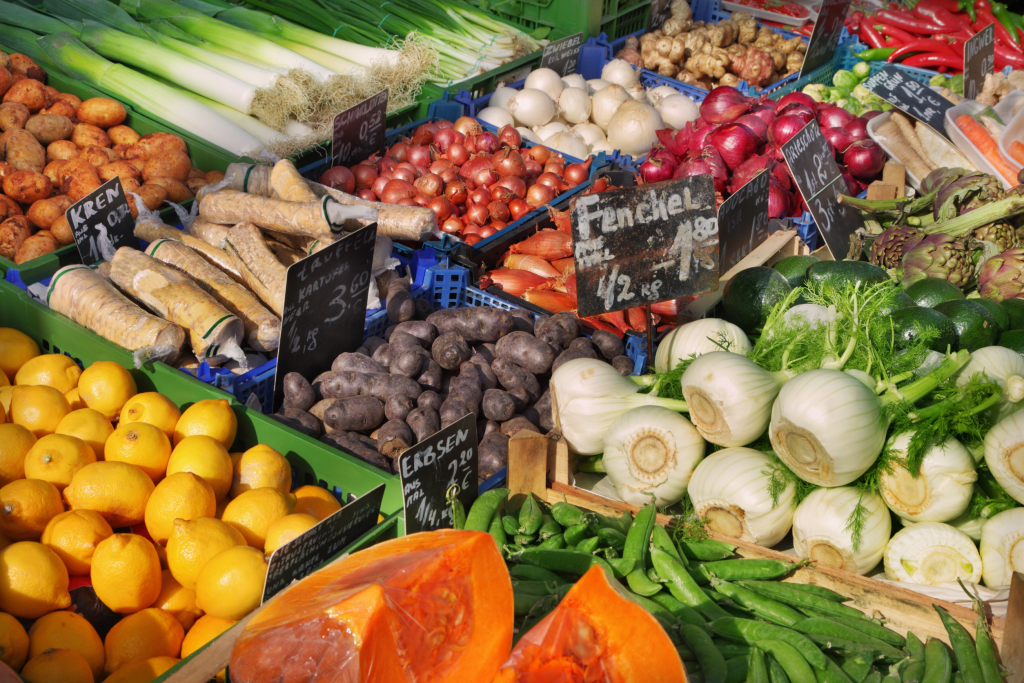
Here, we looked at some of the dirty dozen fruits and veggies you should always buy organic to discover which grocer offers better prices on cleaner produce: Whole Foods or Trader Joe’s.
| Product | Trader Joe’s | Whole Foods | Savings |
| 1 lb Organic Baby Spinach | $3.05 | $4.99 | $1.94 (38.88%) |
| 1 lb Organic Spring Mix | $6.37 | $4.99 | $1.38 (21.66%) |
| 5 lbs Organic Baking Potatoes | $3.99 | $4.99 | $1.00 (20.04%) |
| 1 Organic Romaine Heart | $0.83 | $0.90 | $0.07 (7.78%) |
| 1 lb Baby Carrots | $1.29 | $1.49 | $0.20 (13.42%) |
| 1 Organic English Cucumber | $2.49 | $2.49 | $0.00 (0%) |
| 6 oz Organic Blueberries | $3.49 | $3.00 | $0.49 (14.04%) |
| 1 lb Organic Kiwi | $3.29 | $4.99 | $1.70 (34.07%) |
| 12 oz Organic Pitted Medjool Dates | $4.99 | $8.29 | $3.30 (39.81%) |
| Total | $29.79 | $36.13 | $6.34 (17.55%) |
It turns out that Trader Joe’s beat Whole Foods when it came to the lowest prices on organic produce. Although the $6 difference is less than 20% savings, it’s probably still worth it to shop at Trader Joe’s for organic produce if your priority is cheap food.
But it’s important to mention that Whole Foods had way more options when it came to organic produce, and they’re more likely to carry specialty produce items like heirloom tomatoes or parsnips that you usually wouldn’t find at your regular grocery store.
So, if you love variety and lots of options, choose Whole Foods. If you like low prices at the cost of choices, choose Trader Joe’s for organic produce.
Trader Joe’s vs. Whole Foods: Non-Organic Produce Price Comparison
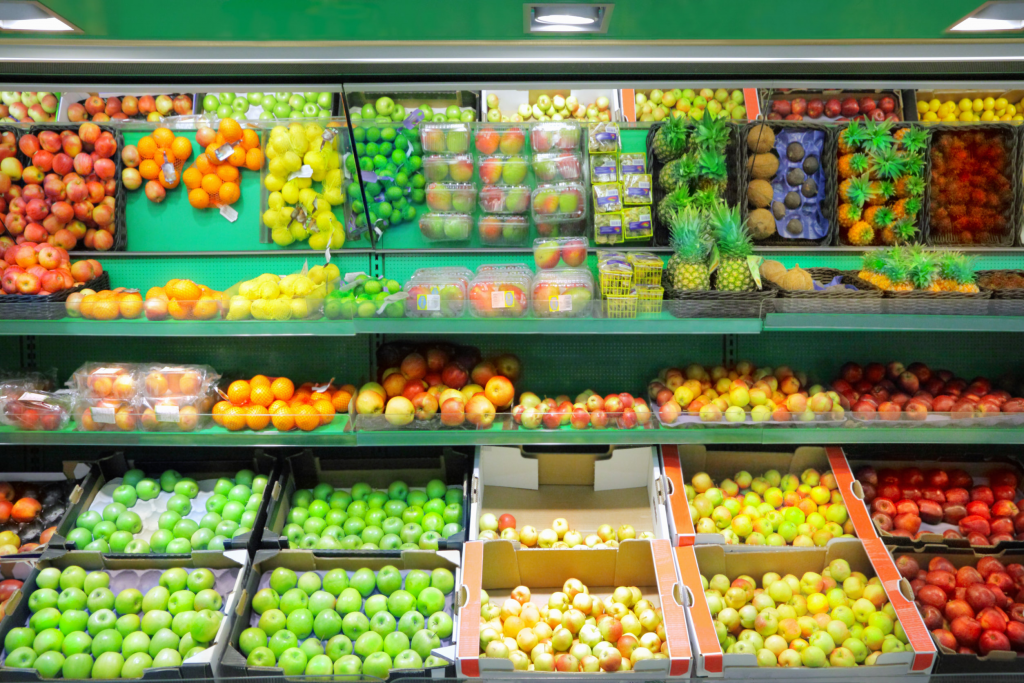
On the other hand, organic produce is more expensive, so if you want to buy the clean fifteen (foods that are unlikely to be contaminated with pesticides) and more, here’s the price comparison on regular produce for you.
| Product | Trader Joe’s | Whole Foods | Savings |
| 6 Small Avocados | $3.99 | $3.49 | $0.50 (12.53%) |
| 4 Cobs of Sweet Corn | $3.99 | $5.99 | $2.00 (33.39%) |
| 1 Pineapple | $2.99 | $3.99 | $1.00 (25.06%) |
| 1 lb Grape Tomatoes | $2.49 | $3.99 | $1.50 (37.59%) |
| 1 lb Cauliflower | $3.05 | $2.49 | $0.56 (18.36%) |
| 1 lb Button Mushrooms | $3.58 | $4.99 | $1.41 (28.26%) |
| 1 lb Navel Oranges | $2.07 | $1.99 | $0.08 (3.86%) |
| 3 lb Bananas | $1.71 | $1.47 | $0.24 (14.04%) |
| 10 oz Strawberries | $5.81 | $3.99 | $1.82 (31.33%) |
| 2 lbs Peaches | $3.50 | $5.38 | $1.88 (34.94%) |
| 1 lb Apricots | $2.69 | $3.99 | $1.30 (32.58%) |
| Total | $35.87 | $41.76 | $5.89 (14.1%) |
Again, we found out that we could save about $6 by shopping for regular produce at Trader Joe’s instead of Whole Foods. While not every option was cheaper (Whole Foods offered marginally lower prices on items like bananas, strawberries, and cauliflower), it’s safe to say that Trader Joe’s is cheaper than Whole Foods–at least when it comes to produce, organic or otherwise.
Remember, Trader Joe’s is less likely to carry organic produce in general, and they’re less likely to offer as many options as Whole Foods, but they still supply all the fruits and veggies you need to stay healthy–and at (usually) lower prices!
Trader Joe’s vs. Whole Foods: Dairy Products Price Comparison

Next on the list, we have dairy (and faux dairy) products. Is Trader Joe’s or Whole Foods a better place to buy your milk and cheese? Let’s find out.
| Product | Trader Joe’s | Whole Foods | Savings |
| 8.8 oz Salted Butter (Trader Joe’s vs. 365 by Whole Foods Market) | $3.69 | $3.29 | $0.4 (10.84%) |
| 59 oz 2% Milk (Trader Joe’s vs. Organic Valley) | $3.99 | $3.13 | $0.86 (21.55%) |
| 5 oz Plain Cottage Cheese (Trader Joe’s vs. 365 by Whole Foods Market) | $1.19 | $1.03 | $0.16 (13.45%) |
| 12 oz Shredded Lite Mozzarella Cheese (Trader Joe’s vs. 365 by Whole Foods Market) | $3.29 | $4.72 | $1.43 (30.3%) |
| 8 oz Grated Parmesan Cheese (Trader Joe’s vs. 365 by Whole Foods Market) | $2.99 | $5.59 | $2.6 (46.51%) |
| 64 oz Non-Dairy Oat Milk (Trader Joe’s vs. Oatly) | $3.99 | $4.99 | $1 (20.04%) |
| Total | $19.14 | $22.75 | $3.61 (15.87%) |
Again, Whole Foods had way more options, especially for non-dairy products like oat, almond, and hemp milk, but Trader Joe’s is cheaper for those same non-dairy products and good old cheese. Whole Foods does beat Trader Joe’s on regular dairy products, like milk and butter, though.
Overall, Trader Joe’s was the winner for lower prices yet again, and we saved about $4 shopping in the dairy department at Trader Joe’s.
Trader Joe’s vs. Whole Foods: Frozen Foods Price Comparison
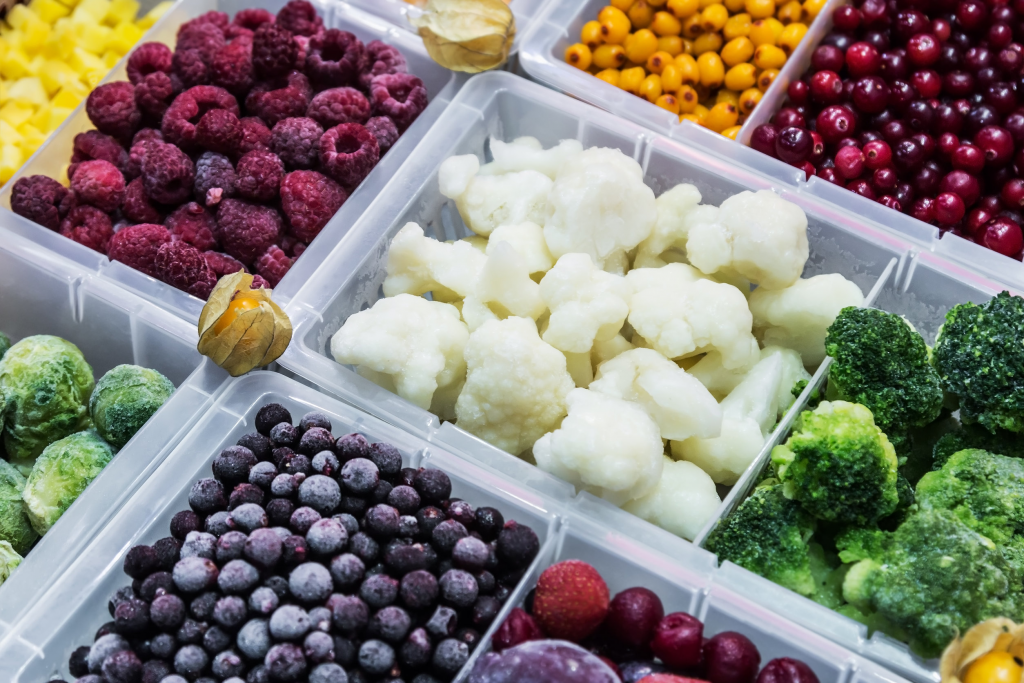
Frozen foods are a great convenient staple for any home. Once the fresh stuff is gone (and you don’t feel like running to the grocery store again), frozen foods arrive at the rescue! But where is the better place to shop for frozen staples? Whole Foods or Trader Joe’s?
| Product | Trader Joe’s | Whole Foods | Savings |
| 16 oz Riced Cauliflower (Trader Joe’s vs. 365 by Whole Foods Market) | $2.99 | $3.99 | $1 (25.06%) |
| 16 oz Black Bean Taquitos (Trader Joe’s vs Starlite) | $3.99 | $6.85 | $2.86 (41.75%) |
| 10 oz Acai Bowl (Trader Joe’s vs. Sambazon) | $3.99 | $7.36 | $3.37 (45.79%) |
| 1 lb Frozen Broccoli | $1.49 | $1.69 | $0.2 (11.83%) |
| 1 Frozen Pizza (Trader Joe’s vs. 365 by Whole Foods Market) | $4.49 | $3.99 | $0.5 (11.14%) |
| Total | $16.95 | $23.88 | $6.93 (29.02%) |
Again, Trader Joe’s was cheaper than Whole Foods–and this time, it was a nearly 30% difference! The frozen foods aisle adds another $7 to how much we can save by shopping at Trader Joe’s instead of Whole Foods, and there’s another reason you might want to choose TJ’s frozen aisle.
Trader Joe’s wins the award for “most creative” with items like Cauliflower Pancakes and Kung Pao Chicken Mochi Balls. The TJ’s brand offers crazy and innovative frozen foods that combine things you’ve never thought of–and the best part is that they taste great!
So, if you’re bored of the standard frozen fruits and veggies, consider shopping for easy meals at Trader Joe’s. But be careful. If you don’t already buy these foods, shopping at TJ’s could increase your grocery bill!
Trader Joe’s vs. Whole Foods: Non-Perishable Groceries Price Comparison

Now it’s time to stock the pantry with non-perishable foods everyone needs.
| Product | Trader Joe’s | Whole Foods | Savings |
| 5 oz Avocado Oil Spray (Trader Joe’s vs. Chosen Foods) | $3.49 | $7.44 | $3.95 (53.09%) |
| 16.9 oz Extra Virgin Olive Oil (Trader Giotto’s vs. Whole Foods Market) | $7.99 | $6.50 | $1.49 (18.65%) |
| 2 lbs Organic Basmati Rice (Trader Joe’s vs. 365 by Whole Foods Market) | $4.49 | $4.99 | $0.50 (10.02%) |
| 5 lbs Organic Unbleached All-Purpose Flour (Trader Joe’s vs. Arrowhead Mills) | $3.99 | $7.99 | $4.00 (50.06%) |
| 12 oz Peanut Butter Granola (Trader Joe’s vs. Nature’s Path Organic) | $3.49 | $4.99 | $1.50 (30.06%) |
| 12 oz Organic Almond Butter (Trader Joe’s vs. 365 by Whole Foods Market) | $7.99 | $8.24 | $0.25 (3.03%) |
| Total | $31.44 | $40.15 | $8.71 (21.69%) |
To no one’s surprise, we discovered that Trader Joe’s offers lower prices than Whole Foods when it comes to non-perishable items you can stock your pantry with. In this section, Trader Joe’s beat Whole Foods on every item except olive oil.
Overall, we saved almost $9 by choosing to fill our pantry with food from Trader Joe’s instead of Whole Foods.
Trader Joe’s vs. Whole Foods: Fresh Prepared Foods Price Comparison

We all have those days when we just don’t have the time, energy, or ingredients to cook. Prepared foods can be more expensive than buying groceries and cooking yourself since you pay for the convenience–but that doesn’t mean there isn’t a cheaper option. Let’s find out who offers the best deals on prepared foods, Whole Foods or Trader Joe’s.
| Product | Trader Joe’s | Whole Foods | Savings |
| 12 oz Caesar Salad Kit (Trader Joe’s vs. 365 by Whole Foods Market) | $3.99 | $6.47 | $2.48 (38.33%) |
| 10 oz Prepared Breakfast Burrito (Trader Joe’s vs. Whole Foods Market) | $4.99 | $4.39 | $0.60 (12.02%) |
| 20 oz Prepared Broccoli Cheddar Soup (Trader Joe’s vs. Whole Foods Market) | $4.49 | $6.66 | $2.17 (32.58%) |
| 16 oz BBQ Pulled Chicken (Trader Joe’s vs. Whole Foods Market) | $5.99 | $7.99 | $2.00 (25.03%) |
| 8 oz Ready-Made Cheese Ravioli (Trader Joe’s vs. 365 by Whole Foods Market) | $3.17 | $4.89 | $1.72 (35.17%) |
| Total | $22.63 | $30.40 | $7.77 (25.56%) |
When it comes to fresh prepared food quality and availability, Whole Foods has Trader Joe’s beat. Some Whole Foods locations even offer a fresh food buffet-style bar, where you can take your pick of various prepared foods and make a plate that satisfies all your cravings.
But, Trader Joe’s wins yet again with the lowest prices all around. If you often eat prepared foods and care about the quality of your meal, Whole Foods is probably better for you. But if you want something that will save you time and money, go with Trader Joe’s.
Trader Joe’s vs. Whole Foods: Packaged Snacks Price Comparison
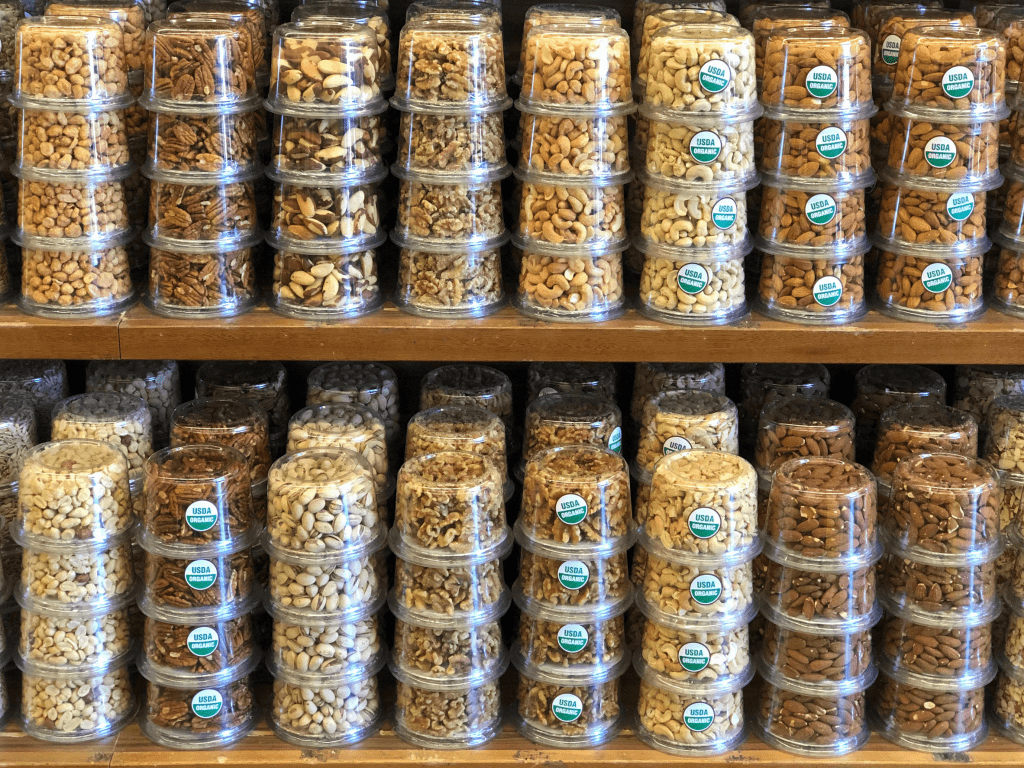
Like prepared foods, packaged snacks are convenient. But, they can also drive up your grocery bill with enjoyable and convenient foods that don’t fill you up as much as you wish. Regardless, if these packaged snacks are a regular part of your grocery shopping trips, here’s what you need to know.
| Product | Trader Joe’s | Whole Foods | Savings |
| 1 lb Raw Almonds (Trader Joe’s vs. 365 by Whole Foods Market) | $4.99 | $7.99 | $3 (37.55%) |
| 5.5 oz Pre-Popped Kettle Corn (Trader Joe’s vs. Boom Chicka Pop) | $2.29 | $2.36 | $0.07 (2.97%) |
| 32 oz White Corn Tortilla Chips (Trader Joe’s vs. 365 by Whole Foods Market) | $3.49 | $4.09 | $0.60 (14.67%) |
| 6 oz Potato Chips (Trader Joe’s vs. 365 by Whole Foods Market) | $2.29 | $1.50 | $0.79 (34.5%) |
| 2.64 oz Sea Salt Dark Chocolate Bar (Trader Joe’s | $1.99 | $2.64 | $0.65 (24.62%) |
| Total | $15.05 | $18.58 | $3.53 (19%) |
Trader Joe’s came out on top again. We saved about 20% by choosing TJ’s over Whole Foods for our packaged snack needs like popcorn and chips. Are you starting to see the pattern here?
Trader Joe’s vs. Whole Foods: Beverages Price Comparison

Next up, we have beverages. Drinks are another item that can contribute to needless spending habits, but that doesn’t mean we don’t buy them anyway! Here’s the dish on the cheapest drinks at Whole Foods and Trader Joe’s.
| Product | Trader Joe’s | Whole Foods | Savings |
| 32 oz Ready to Drink Cold Brew Coffee (Trader Joe’s vs. Chameleon Cold-Brew.) | $4.99 | $8.99 | $4 (44.49%) |
| 12 12 oz Cans of Watermelon Sparkling Water (Trader Joe’s vs. La Croix) | $4.94 | $4.29 | $0.65 (13.16%) |
| 750 ml Red Blend Wine (Organic Charles Shaw vs. Bubo Wine Cellars) | $3.99 | $7.99 | $4 (50.06%) |
| 12 oz Cold Pressed Orange Juice (Trader Joe’s vs. | $1.99 | $1.83 | $0.16 (8.04%) |
| 6 12 oz Cans of Beer (Boatswain Double IPA vs. Wolf Pup Session IPA) | $4.99 | $9.79 | $4.8 (49.03%) |
| Total | $20.90 | $32.89 | $11.99 (36.45%) |
After purchasing drinks, we discovered that Trader Joe’s, yet again, offers lower prices than Whole Foods. This time we were able to keep over $10 in our pockets and out of the register!
We saved the most money shopping at Trader Joe’s for drinks instead of Whole Foods. Even though some items are slightly cheaper at Whole Foods, when items were cheaper at Trader Joe’s, we saw steeper savings.
Nothing beats Trader Joe’s iconic “Two Buck Chuck” Charles Shaw wine. While it’s a bit more than just $2 these days, the Charles Shaw brand (which sells exclusively at Trader Joe’s) offers some of the best wine deals you’ll ever get.
Trader Joe’s vs. Whole Foods: Personal Care Items Price Comparison

Although Trader Joe’s and Whole Foods are both grocery stores first, they do offer a selection of personal care products for shoppers who prefer not to stop at multiple stores when they run errands. And there’s a clear winner for who offers the lowest prices here.
| Product | Trader Joe’s | Whole Foods | Savings |
| 16 oz Liquid Body Wash (Trader Joe’s Citrus Refresh vs. 365 by Whole Foods Market Aloe & White Tea) | $2.99 | $5.29 | $2.3 (43.48%) |
| 6 oz 50 SPF Spray Sunscreen (Trader Joe’s vs. 365 by Whole Foods Market) | $5.99 | $11.53 | $5.54 (48.05%) |
| 4 oz Solid Shampoo Bar (Trader Joe’s Peppermint & Tea Tree vs. HiBar Moisturize) | $3.99 | $14.86 | $10.87 (73.15%) |
| 8 oz Body Butter (Trader Joe’s Brazil Nut vs. Pacha Soap Co. Lavender) | $5.99 | $14.83 | $8.84 (59.61%) |
| 8.8 oz Bar Soap (Trader Joe’s Almond Ginger Oatmeal Exfoliant vs. 365 by Whole Foods Market Shea Butter) | $2.99 | $6.49 | $3.5 (53.93%) |
| Total | $21.95 | $53.00 | $31.05 (58.58%) |
Trader Joe’s demolished Whole Foods in the personal care products price comparison. After saving over $30, we found that Trader Joe’s products are more than half as expensive as the ones sold at Whole Foods. So, the lesson here is that you shouldn’t buy soap at Whole Foods.
Again, it’s worth mentioning that Trader Joe’s has a more limited selection when it comes to personal care products. So, if you’re particular about scents or brands, a store with more options might be better for shopping for personal care products.
Trader Joe’s vs. Whole Foods: Services and Public Perception Comparison
In terms of public perception and services offered, Whole Foods and Trader Joe’s are at a close tie. The biggest difference between these two health foods stores is likely the store-brand products which largely contribute to Trader Joe’s image and cult following.
Whole Foods offers store-brand products under the label 365 by Whole Foods Market, and these products are good quality items. But, they are still pricier than those offered at TJ’s.
On the other hand, Trader Joe’s brand-name products are infamous not only for their quality but their creativity, too. Although Trader Joe’s tries to keep their suppliers anonymous, the secret is out that TJ’s brand-name items are really your favorite brands in disguise. Under the Trader Joe’s label, you can find Stacy’s Pita Chips, Naked Juice, Snack Factory Pretzels, Tribe Hummus, and more.
If you’ve never shopped at Trader Joe’s, you should also know that they’re a bit quirky compared to other stores. They put a strong emphasis on making the shopping experience fun and enjoyable, and that’s why they use bells instead of a PA system to communicate.
Here are some other services that Trader Joe’s and Whole Foods offer, and who wins out in each category.
| Service | Trader Joe’s | Whole Foods |
| Curbside Pickup | Trader Joe’s does not offer curbside pickup to customers. | Some Whole Foods locations offer free curbside pickup. |
| Shipping and Delivery | Trader Joe’s does not offer in-house shipping or delivery services. But you can use third-party services like Postmates and Instacart. | Since Whole Foods was acquired by Amazon in 2017, shoppers can purchase groceries from Whole Foods through Amazon Prime for delivery. The catch is that you must pay separately for a Prime membership, which costs $12.99 a month or $119 a year. |
| Return Policy | Trader Joe’s offers a lenient return policy, where you can return any item, with or without a receipt, in any condition (and that includes partially eaten!). | Whole Foods’ return policy requires customers to have a receipt and return items within 90 days of purchase. If you paid with a credit, debit, or gift card, they might be able to look up your receipt for you. Whole Foods also makes it easy to return items purchased through Amazon. You just need to bring the item into a Whole Foods location after starting Amazon’s return process online. |
| Variety | Trader Joe’s locations tend to be smaller and offer fewer options to consumers. | Whole Foods definitely offers more variety for shoppers. |
| Loyal Customers | Trader Joe’s has a fan base like no other, probably thanks to their house brand products that never fail to impress. | While shoppers love Whole Foods, the high prices and brand-name goods don’t drive customers to worship Whole Foods the same way they love Trader Joe’s. |
| Customer Service | Trader Joe’s employs some of the friendliest and most helpful people you’ll ever meet–and the good benefits and pay probably have something to do with it. TJ’s beats Whole Foods for outstanding customer service. But don’t be mistaken, Whole Foods still has great employees! | Whole Foods staff do not disappoint when it comes to customer service, but many customers report issues with the delivery service. |
FAQs About Trader Joe’s and Whole Foods
Who owns Trader Joe’s and Whole Foods?
Whole Foods is owned by the multibillion-dollar conglomerate Amazon. On the other hand, Trader Joe’s is owned by the Albrecht family, a German family who also owns Aldi Nord. Theo Albrecht was the original owner of Trader Joe’s back in 1967 when it was founded by Joe Coulombe. To learn more about how Trader Joe’s and Whole Foods compare, check out Koopy.com’s ultimate price comparison.
Is it better to work for Whole Foods or Trader Joe’s?
Trader Joe’s is one of the best companies to work for in the US They have a 4.3 rating as an employer on Glassdoor and pay employees an average hourly wage of $15.09 (which is 28% above the national average). Meanwhile, Whole Foods has a 3.5 rating as an employer, and they pay frontline employees the national average wage of $12.58 an hour.
Since working at Trader Joe’s is so great, the competition is fierce, and it’s harder to get a job at Trader Joe’s than Whole Foods. Learn more about the similarities and differences between Whole Foods and Trader Joe’s in Koopy.com’s ultimate price comparison.
How much more expensive is Whole Foods than Trader Joe’s?
In our ultimate price comparison, we found that shopping at Whole Foods is, on average, 29% more expensive than shopping at Trader Joe’s. Check out our full, detailed comparison for a more in-depth look at the pros and cons of shopping that Trader Joe’s and Whole Foods, including what you should never buy at Whole Foods.
What’s the difference between Trader Joe’s and Whole Foods?
The main difference between Trader Joe’s and Whole Foods is that Trader Joe’s is a smaller company that cares about employees and consumers. They go the extra mile to provide great service, from their bell system to their Trader Joe’s brand foods to their return policy. However, shopping at Whole Foods means more variety, more options, and better pickup and delivery options. But, you pay for the Whole Foods experience since it’s 29% more expensive than Trader Joe’s.
Which is better, Trader Joe’s or Whole Foods?
Trader Joe’s and Whole Foods both have unique pros and cons, but Trader Joe’s is about 30% cheaper than Whole Foods. Trader Joe’s does not offer curbside pickup or delivery. Whole Foods has more product options. To learn which store is best for you, check out Koopy.com’s ultimate price comparison, where we dive into all the pros and cons of each store.
Final Thoughts: Trader Joe’s vs. Whole Foods
In our opinion, Trader Joe’s is the better health foods store. They treat employees and customers better, offer lower prices, and possess the impressive and infamous TJ’s brand. And while Whole Foods does offer more perks like delivery, curbside pickup, and more variety, when you shop at Whole Foods, you pay for the experience. And it’s a steep fee.
If you’re still not sure which store is better for you, here’s a quick rundown.
You should shop at Trader Joe’s if:
- You want lower prices on foods that are still healthy.
- You prefer a limited selection that makes shopping easier and saves you time.
- You don’t mind getting “special” foods when the “regular” options aren’t in stock.
- You always shop in-store.
Whole Foods is a good choice if:
- You don’t mind paying premium prices for high-quality groceries.
- You want more options when it comes to organic produce.
- You’re fine with buying organic items when no non-organic items are available.
- You have allergies and like to shop for specialty products.
- You’re okay with limited variety when it comes to meat products.
- You want the convenience of grocery delivery and curbside pickup.
Now that you know the differences between Whole Foods and Trader Joe’s, you can learn more about money-saving deals and discover coupons on Koopy.com!

Meats and fish quality at both?
Great analysis and super helpful, thanks a lot!
Just one common but big mistake I would like to point out is that the statement “But, you pay for the Whole Foods experience since it’s 29% more expensive than Trader Joe’s” is wrong. Trader Joe’s is 29% cheaper than Whole Foods, yes, that’s correct (you save 29% if you were a WF customer but later switch to TJ). But it also means that Whole Foods is 41% more expensive than TJ, not 29% (you spend 41% more if you were a TJ customer who later switched to WF).
What about flavor? I don’t see this addressed at all. We mostly shop traders and just occasionally at whole foods for small number of things but consistently find whole foods fruit tastes sweet whereas the same at trder joes although cheaper tastes watered down. Is it possible wf is tasting their fruit ? Can growers speed up the process of production by pumping fruit full of water and hereby losing taste of the fruit? Traders likely not tasting the product.